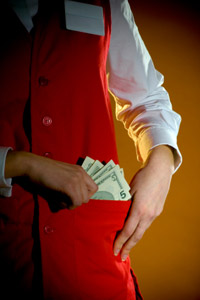
The best case scenario in this situation is always to catch the scam before it spreads. One server successfully executing a scam can lead to others following suit. This can mean an epidemic of theft that robs you of both money and a good portion of your staff.
Most people are honest and will not steal. The perfect storm of watching others benefit from the scam and thinking it is harmless to a large corporation provides justification to otherwise honest servers. Knowing how to catch these scams before they cost your restaurant money and staff is vital.
Here are 5 basic scams to watch out for:
1. The Penny Trick
This scam dates back well before my time in restaurants. A bartender places a penny, paper clip, or other item in the bar drawer each time they don’t ring in a cash drink. This is generally done with the same drink so the bartender can multiply the price of the drink by the number of items to know how much to pull from the drawer and place in their pocket.
The way to catch this one is simple. Most registers now have a large “no sale” message on the screen when the drawer is opened to make change. If money goes in the drawer at this point, there may be a problem. Bar drawers should be audited for any irregularities. No personal items should be allowed behind the bar. This also will prevent the theft of a bottle. The first line of defense though is to not have your drink prices end in even numbers. $3.00 draws including tax might be easier on your guests, but it also makes it easy for a thief.
2. Post Payment Adjustments
This one might be the most common and the most costly. Servers will ask the manager for an adjustment (comp, void, coupon, etc) to a check. What the manager does not know is that the table has already left and paid in cash. The server pockets the difference in the check before and after discount. This is increasingly common with the number of coupons and discounts offered entice guests to dine in a slow economy.
While it is the most common, it is also the easiest to combat. As soon as a manager does one of these discounts, they should visit the table. If the table is not there or has just started the meal, further investigation is required. This is also a great opportunity for a table touch anyway to ask how they got the coupon and when you will see them back.
3. The Buffet Trick
I knew of this trick before I waited my first table. At a restaurant where a ticket is not required to get food from the kitchen, a server will simply drop the check of a previous table with an identical tab. This is most common on salad bars and buffets. The restaurant is out the food and the server pockets the entire check.
If you run a buffet style restaurant and do not have procedures in place to combat this, this is most likely already happening. The simplest protocol here is to match the number of guests to the number the server charges for. I have seen this done in a number of ways, but the easiest is matching serial numbers on two chits. One is placed on the table by the host and retained by the server. The other is kept at the host stand. At the end of the night the numbers are matched to insure every meal is accounted for.
4. The Floating Soda
This is another old scam that should be addressed by modern POS systems. A server charges a table for their meal and their soda. If the table pays with cash, the soda is transferred to another table prior to closing the tab. This allows the server to pocket the price of a single soda numerous times. While this may not seem substantial, over time it adds up.
Your POS system should not allow servers to transfer any item without manager approval. Honest mistakes do happen and sometimes a manager will need to do this. Choosing not to make this task the manager’s responsibility is the equivalent of allowing it to occur. No matter how much you trust your staff, this temptation should be eliminated. Sodas should also be set up as a separate tracking category and servers with low soda sales should draw special attention.
5. Padding Checks
This one is the toughest to catch, but the most dangerous to your reputation. The restaurant is not directly out any money on this scam. Instead the server simply adds an extra drink to the guest’s tab. This is usually done with the same drink the guest is already having. The guest chalks it up to having one more than they thought and pays the bill without question. The server consumes the drink and continues to serve their guests.
This one is tough to catch because it will not show up on any report. The effects can be wildly felt though. If the guest catches it, they will raise hell. The number of people a scammed guest will tell dwarfs the number in the old adage about unhappy guests telling more people than a happy guest. You also are now left with a drunk server on your floor. Clear plastic cups for employee drinks and frequent communication with your servers throughout the night is the best way to catch this scam.
This is most certainly only a partial list. It does not include short-term scams that will be caught within the week. An employee that is trying to steal from you will show incredible ingenuity. Knowing how to prevent these most common ones will make it far more difficult. The key is deterrence and preventing the spread before it costs your restaurant money, staff, and reputation.
